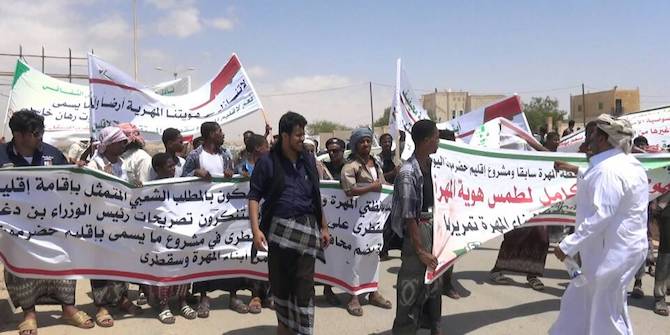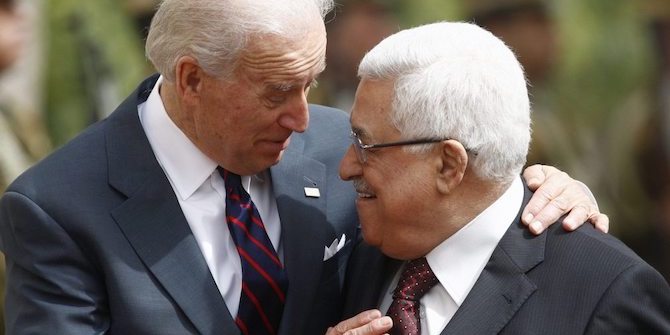by Eleonora Ardemagni

Three years after my LSE blog post Emiratis, Omanis, Saudis: the rising competition for Yemen’s Al Mahra, Yemen’s Al Mahra has become an example of ‘collateral militarisation’. I use this concept to describe a stable region geographically close to a conflict area whose local system, although separate from the main war actors and dynamics, is affected by externally driven militarisation. In fact, the Saudi military presence has risen despite the south-eastern region remaining untouched by the conflict between the Houthis and their opponents, and far from the Northern Zaydi insurgents’ radars.
Nowadays, the geographically remote Al-Mahra can’t be analysed without taking into account the geopolitical factor, which likewise permeates the war throughout Yemen. The regional competition for leverage among the Gulf monarchies has become a polarising factor upsetting local balances, and this remains so in this border region. The United Arab Emirates (UAE) have since 2017 reduced their presence in Al-Mahra, instead focusing upon the Socotra archipelago (another theatre of ‘collateral militarisation’). Taking their opportunity, Saudi Arabia have sent soldiers since November 2017 to counter smuggling activities and, most importantly, the import of Iranian-made weapon components destined for the Houthis. The Saudis have established some military facilities in coastal and land areas, supported by pro-Saudi Yemeni fighters from other Southern regions or local military allies. In response, the neighbouring Sultanate of Oman has increased financial efforts to counter Saudi influence, trying to preserve its traditional leverage across the borderland linking Al-Mahra to the Omani Dhofar.
Although Mahris are caught in an indirect struggle much bigger than local politics, they are showing restraint and resilience. The incidence of skirmishes has risen, with a Saudi Apache helicopter bombing a border checkpoint in April 2019 during clashes between Saudi forces and Mahri tribes active in cross-border activities. However, wide-scale violence has been avoided so far. Mahris are now divided between supporters of Saudi Arabia and the pro-Omani camp: this fragile balance will likely endure only if local interests are not directly challenged by foreign states’ agendas, which would likely provoke a backlash against external forces.
As one of the very few Italian analysts regularly focused on Yemen, I had to learn to deal with the country’s amazing complexity, about which I still learn much every day. I have come to know how much information is required trying to convey this in either an article, a seminar or during a 2–3 minute interview on the radio. I think Al-Mahra aptly frames Yemen’s complexity – the region’s uniqueness in such a diverse country offers a ‘story within the story’ of the war that began in 2015. Even seasoned Middle East-watchers are usually surprised to discover that Yemen is not what it seems at first glance – one need only think of the frequent applications of a short-sighted ‘sectarian war’ paradigm, or the widespread belief that the Houthis are not also responsible for human rights violations. In Yemen, there’s always a deeper, more nuanced and often political – rather than religious – perspective that can explain what is happening. The idea of an LSE blog post on the rising regional rivalry for Al-Mahra came from here.
In the last three years, Saudi Arabia has managed to become a powerful actor in Al-Mahra. The kingdom has deployed security forces and embarked upon development projects for an area in dire need of electricity provision and services, in doing so establishing patronage ties with some Mahri tribes. In June 2019, Saudi and Yemeni Special Forces captured two Islamic State leaders in Al-Mahra, but jihadism had never found space here before, as Mahris are Sunnis of a mainly Sufi orientation. For Saudi Arabia, Al-Mahra is a gate to the Arabian Sea and the Indian Ocean – this has added value since Aden and Mukalla (Hadhramawt) are still controlled by pro-Emirati forces. Access to Al-Mahra’s main ports, Al-Ghayda and Nishtun – now controlled by Saudi forces – allows Riyadh to bypass the (Iranian and Omani-controlled) Strait of Hormuz to ‘go East’ (to India and China) and to ‘go South’ (to the Horn of Africa). Such an ability would be crucial for trade and oil exports. In September 2019, the Saudi Development and Reconstruction Program for Yemen started to develop the port of Nishtun to enhance its commercial capacity, with the aim of creating a terminal for a pipeline linking Saudi oil fields to Al-Mahra.
Throughout history, Al-Mahra has distinguished itself as an autonomous player wary of external meddling: its residents are fiercely proud of their culture, habits and linguistic identity. Even before the 2015 war, the governorate used to rely on traditional and/or local authorities and was neglected by Sanaa-based central institutions – Al-Mahra enjoyed de facto self-governance, as described by the scholar Elisabeth Kendall. Moreover, Mahris have a strong, community-oriented tribal code which limits the occurrence of conflicts among tribes and especially among clans belonging to the same tribe, argues researcher Ahmed Nagi. This is the context in which locals staged vibrant protests against the opening of Saudi-sponsored Salafi centres in 2018, and why the UAE attempt to build a functioning Mahri Elite Force failed after the Emiratis organising it circumvented local authorities.
Al-Mahra has not been affected by the war between the Houthis and the Saudi-led coalition supporting the internationally recognised government – very few sentences of the UN Panel of Experts on Yemen 2020 report make mention of the situation there. Instead the war in Yemen has offered the Gulf’s regional powers opportunities and pretexts to enter quiet and autonomous areas such as Al-Mahra and also Socotra. This has altered indigenous balances of power, prompting local leaders to take sides in external rivalries in order to preserve or improve their status and benefits. As local and external interests bind themselves to eachother, finding the way to disentangle a patron-client relationship becomes increasingly arduous and risky: one more obstacle on the road towards a future unified Yemeni state.
Indeed, the war that did not reach Al-Mahra has made possible the ‘collateral militarisation’ of this strategic borderland.
This is part of a series revisiting the Centre’s most popular blogs of the past decade, celebrating our tenth anniversary and asking the authors to return to their pieces and offer some updates. Read the introduction here, and see the other pieces below.
In this series:
- Introduction by Jack McGinn
- The 3000, Five Years Later: The Tunisians Who Joined Daesh by Youssef Cherif
- The Way Forward for Syrian Survivors of Sexual Violence by Marie Forestier
- Dishdasha Blues: Navigating Multiple Lived Experiences in the Gulf by Rana AlMutawa
- Sectarianism to Nationalism Reconsidered by Raad Alkadiri
- Caught in the Gulf Rivalry: Yemen’s Al Mahra Avoids the War Despite ‘Collateral Militarisation’ by Eleonora Ardemagni
- The Future of the Syrian Democratic Forces: One Year after the Liberation of Baghouz and the Turkish Invasion by Wladimir van Wilgenburg
- Biden’s Impending Billions to Palestine by Alaa Tartir
- Ruling Family Solidarity at the Expense of Bahrain’s Unity by Ali Al-Aswad
- Peacebuilding Without Protection? Yemeni Women’s Barriers to Peace by Rasha Jarhum







10 Comments